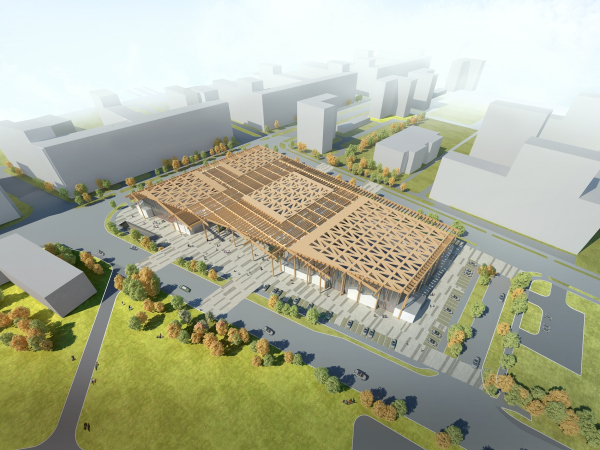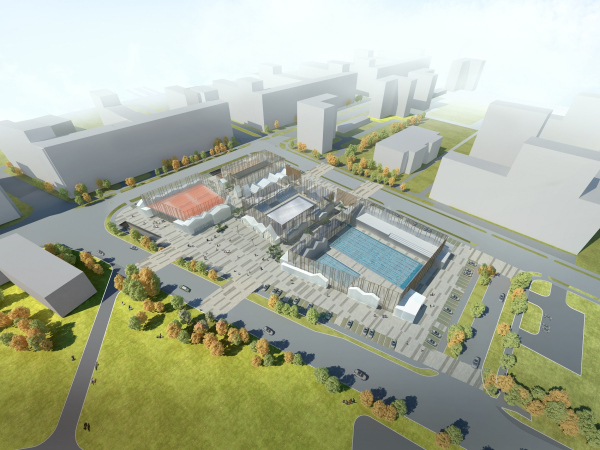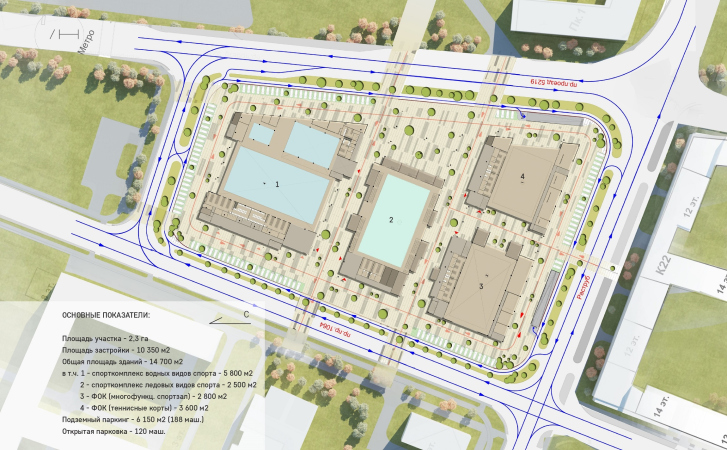The “Sportpark” project was created by ASADOV architects for “Gorod na Reke Tushino – 2018” (“Town on the Tushino River”), a grand-scale residential complex built in the stead of the former Tushino Airfield, inscribed into the peninsula between the Moskva River, the Moscow Channel, and the Skhodnya River. This residential area was formed around “Otkrytie Arena” – the home base of Spartak football club, built in 2014 by its owner, Leonid Fedun. The city authorities originally gave their approvals not only for the residential but also for the sports nature of the complex. The developer of “Tushino-2018” was to build here and hand over to the city a few sports facilities, for which he conducted a closed-door competition, to which the Asadov team was invited. The project by the ASADOV architects did not win eventually, yet it did bring about a beautiful and universal idea for the future architecture.
The land site – a rectangle of irregular features – is situated between the park zone and future residential buildings. On this venue, the architects were to place an aquatic center, tennis courts, an ice arena, and a multifunctional gym. The architects designed four glass volumes, and then decided to unite them with a single pergola roof – a glued-wood mega-structure situated on the height of the playing field. There are several entrances to this megastructure. From the chamfered side before the entrance, there is a partially open plaza.
The multifunctional complex “Sportpark”
Copyright: © ASADOV architects
In the center, there is a skating rink, flanked by pedestrian galleries; on the right, there are swimming pools, on the left tennis courts and a youth sports school. The wooden pergola can be both open, and covered with glass. Underneath this “sky”, as Andrey Asadov calls it, one can not only do sports but also go walking around the inner streets, formed by low-rise pavilions, whose silhouette looks a little bit like that of an old north-European city – this archetype of a traditional street is still going strong, and, as it turned out, is not at all at odds with the modern sports futurism.
The multifunctional complex “Sportpark”
Copyright: © ASADOV architects
On the human level, this looks like a small town of little houses with pitched roofs, these roofs being of various heights, steeper or gently sloping ones, the silhouette can be of any kind because all of the houses share the same sky. The facades of the little houses are either completely transparent, including the fronton, or dull, or with a stained glass window showcase – in all of the cases, the plastique is modernist, and not the traditional grid with windows. On the inside, there are locker rooms, mechanical rooms, and the commercial infrastructure. Similar “little houses” with gable roofs, yet without one of the walls, also cover the spectator areas around the skating rink.
The multifunctional complex “Sportpark”
Copyright: © ASADOV architects
The tall glass partitions with vertical wooden sashes are cut into the little houses, and this creates an impression as if this is a little town amidst a pine forest, the pergola casting shadows like from tree branches. The glass and the slim “pines” grow up to the “sky” and separate the inner premises from the outside world, at the same time connecting them: the little town is perceived as its continuation, the streets ending directly under the pergola.
The multifunctional complex “Sportpark”
Copyright: © ASADOV architects
The multifunctional complex “Sportpark”
Copyright: © ASADOV architects
Glass is essentially a boundary that is not there. This little town is maybe an inside or an outside ambivalent space. It was expected that in the evening the Sportpark would glow with a warm light. Being inside, one would be able to see the city behind the glass, at the same time being protected from the wind and the rain.
The multifunctional complex “Sportpark”
Copyright: © ASADOV architects
It’s not that such techniques were not used before in shopping malls, railway stations, and food markets (which all are essentially a combination of small volumes and megastructures covering them), yet here they met with wood and gable roofs. Furthermore, the wooden pergola – an openwork thing with ostentatiously jagged edges – became in this case a structure of a city magnitude.
The multifunctional complex “Sportpark”
Copyright: © ASADOV architects
The ASADOV architects did wooden architecture projects before (“we love wooden things” – Andrey Asadov says). In the tennis center in Moscow’s Kuntsevo, for example, the entrance zone was also made of glued wood. After that, there was a sports complex in Zhukovka-XXI with “flying” triangular wooden roofs. When asked about the fire safety issue of the wooden construction, Andrey Asadov emphasized that wood, if treated correctly, keeps up its bearing capacity many hours after the start of the fire, whilst metal loses it within about an hour and a half. As for the price, the wooden construction is oftentimes is not more expensive than a metal one. “All of our elements are as functional as they can be – Andrey Asadov stresses – It’s just that the construction of the main roof, which was going to be there in any case, was ultimately made of wood, while the inner premises, which also were to be there in any case, we decided to design not as simple boxes but as little houses with a dramatic silhouette. Probably, economy-wise, our client thought of our solution as a unique one. Our project did not ultimately win but we still like it very much because we now have a powerful universal idea in our arsenal. It will sure come handy in the future”.
Usually, all sports facilities in this country, unless they are built for the Olympics or for the World Soccer Championship, are doomed to be hangars. The mere fact that the architects were able to break away from the “box” design is a great achievement in itself and a stepping stone for a better future. The image became softer and more environmentally friendly. Accordingly, the wooden pergola became a universal “sky” for the little town or whatever it is there underneath it. In our climate, the very opportunity for moving around from one house to another without getting your shoes dirty already sounds like an achievement in itself. The pergola must be plain to see from the top floors and become the fifth facade. The weaving pattern of the pergola is diverse, and changed not unlike the pattern on a sweater: there are laconic planks above the pedestrian galleries, while above the sports facilities the ornaments become thicker and more intricate. This was done not just for the sake of decor, but also for functional purposes: at the client’s request, the architects diminished the glazing area at the expense of skylights, giving them a triangular shape.
The multifunctional complex “Sportpark”
Copyright: © ASADOV architects
Now about the formal context of Sportpark! The megastructure that hides the inner streets inside of it is actually a town within a building. A town within a building is a modern architectural form that is different from the traditional palace or a classical architectural ensemble with their inherent symmetry. This is a form that is freer; like a real town, it contains a kaleidoscope or different shapes, yet it still demonstrates a clear “fabric” with streets and buildings united by a common “sky” or some other large figure, it has a beginning and an ending. Such megastructures are to be encountered, for example, in Skolkovo (or in the Herzog and de Meuron project of the University building, and in the Valod and Pistre project in Technopark); in expo architecture, for example, in the Milan Fair designed by Fucsas. And as for the wooden grids, these pop up now and then in the park and garden architecture, for example, in the glass-and-wood “parthenon” in the Citroen Park in Paris. The Tushino Sportpark miraculously combines all of these features: large technological elements, sophisticated city infrastructure, and the subtle wooden architecture.
The wood-and-glass grid and, essentially, the pergola too, are exactly of this kind, quite a nature-friendly image. And, if we are to speak about being inspired by environmental elements, glass in architecture is likened to water or to air. And wood is quite natural as it is. The plants in the tubs add to the likeness with a greenhouse. The image of eco architecture can be expressed with different ways: in vertical gardens on the facade or in burying the building in a green hill. This little town underneath the elegant wooden pergola is yet another convincing image of green architecture. Conservation is on the world’s most prevalent ideologies of today. Some think tanks, like Noah Harry, for example, even believe that nature is ousting the humans, becoming the center of creation, the world becoming more nature-centric, and not anthropocentric, the way it has been since the time of Renaissance. The revenge that nature is taking out on us for the violence that it was subjected to in the course of the previous centuries leads to a situation that is reversely lopsided, some “eco-nazi” thing. In this sense, it is very important that the archetypal little houses with gable roofs in the Sportpark project become the humanity’s agents, reflecting it scale of thinking and perception, which ultimately will lead to overall harmony, will it not?















































